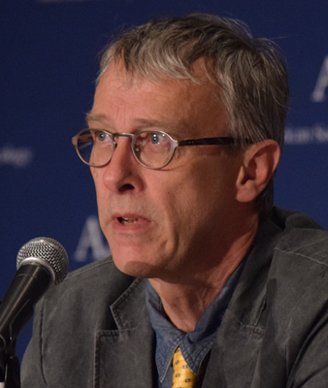ABT-414 Shows Promise Against EGFR-Amplified Glioblastoma
In this interview we discuss findings from M12-356, an open-label, phase I, escalation cohort study of the investigational anti-EGFR antibody-drug conjugate ABT-414 for patients with EGFR-amplified recurrent glioblastoma.
Martin J. van den Bent, MD, PhD

As part of Cancer Network’s coverage of the 21st Annual Scientific Meeting of the Society for Neuro-Oncology, held November 17-20 in Scottsdale, Arizona, we spoke with Martin J. van den Bent, MD, PhD, who heads the Neuro-Oncology Unit at Erasmus MC Cancer Center in Rotterdam, Netherlands. He described findings from M12-356, an open-label, phase I, escalation cohort study of the investigational anti-EGFR antibody-drug conjugate ABT-414 monotherapy for treatment of 48 adult patients with EGFR-amplified recurrent glioblastoma.
-Interviewed by Bryant Furlow
Cancer Network: What did your team find?
Dr. van den Bent: What we found was an encouraging amount of glioblastoma patients free of progression in an ABT-414 mono-cohort recurrent glioblastoma patients all having EGFR amplification.
Why did we consider it encouraging? We have a benchmark that we typically use to evaluate the current glioblastoma trials and we think there is a signal that warrants further investigation if at 6 months about 20% of patients are still free from progression. You must understand that we are used to seeing outcomes of like, 10%, 12%, and 6% of patients with classical cytotoxic agents at 6 months, still free of progression.
What we know here with this cohort of patients was that we have a 25% to over 25% of patients still free from progression and that at least suggested there’s a signal with this compound. That’s very important.
Cancer Network: So your benchmark was stable disease or partial response?
Dr. van den Bent: We typically do not see real responses in the sense of decreased size of tumors, so we take as a benchmark stable disease [SD] for at least 6 months. That has been identified in the past as indicative of improved outcome. That amount of stabilization is meaningful for patients. It means they don’t progress; they don’t get new signs and symptoms. It’s in the nature of the disease that real responses in glioblastoma are very infrequently encountered.
Cancer Network:What is the mechanism of action for ABT-414?
Dr. van den Bent: It is an antibody-drug conjugate, so there’s an antibody attached to a very powerful cytotoxic [agent], monomethyl auristatin F. You need just a couple of those molecules in the cell to kill the cell. It’s a tubulin blocker.
The mechanism of action is not as we have previously been chasing. EGFR amplification, overexpression, is very frequent in glioblastoma. We have been trying in the past to use the same drugs that worked in head and neck or in lung cancer: gefitinib, erlotinib, to inhibit the EGFR receptor. That didn’t work. The main reason is that the mutation you see in lung cancer and head and neck cancer that are related to improved outcome are not present in glioblastoma. The antibody is used to get the cytotoxic [agent] inside the tumor cell-it’s a completely different “trojan horse”-like mode of action, not intending to disrupt the EGFR signaling pathway. But to use the activated receptor to get the cytotoxic [agent] inside the tumor cell.
Cancer Network:Tell us about the safety profile. What treatment emergent adverse events occurred?
Dr. van den Bent: The safety profile is quite exceptional. The typical problems that we anticipate like nausea and myelosuppression, you don’t see. What you do see here is ocular toxicity. At first we thought this was due to some EGFR expression in the corneal cells; the mechanism is keratitis, which causes burning eyes, dry eyes, a foreign feeling in the eyes, and blurry vision if it’s severe. It’s probably not this antibody, this ABT-414-specific, but is probably specific for the toxin attached to the antibody.
Cancer Network:Was the eye toxicity a surprise?
Dr. van den Bent: It was unexpected. This is one of the first compounds in which this cytotoxic [agent] is being used. It’s reversible, so if you stop the treatment, if you lower the dose, if you take some rest, it tends to improve. But it’s really the most frequent complaint that we see with this compound.
Cancer Network:What’s next?
Dr. van den Bent: So based on initial encouraging signals that we saw, a large trial has been developed in EGFR-amplified recurrent glioma. That trial has concluded its enrollment. There has been interim analysis for futility; that did not result in any action, so the trial is continuing. We expect to have the results of that trial by the end of 2017-just over a year from now.
Another project that has been developed is in newly diagnosed EGFR-amplified glioblastoma. That trial is run through NRG [National Surgical Adjuvant Breast and Bowel Project, Radiation Therapy Oncology Group, and the Gynecologic Oncology Group], the large US cooperative group. This trial is ongoing and will obviously require much more time to get results.
Newsletter
Stay up to date on recent advances in the multidisciplinary approach to cancer.